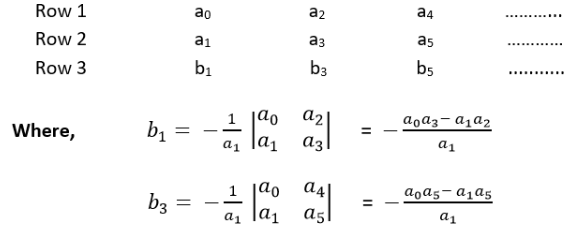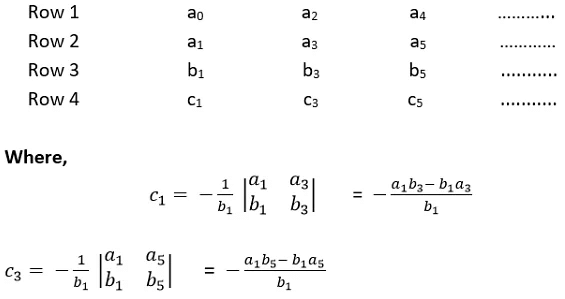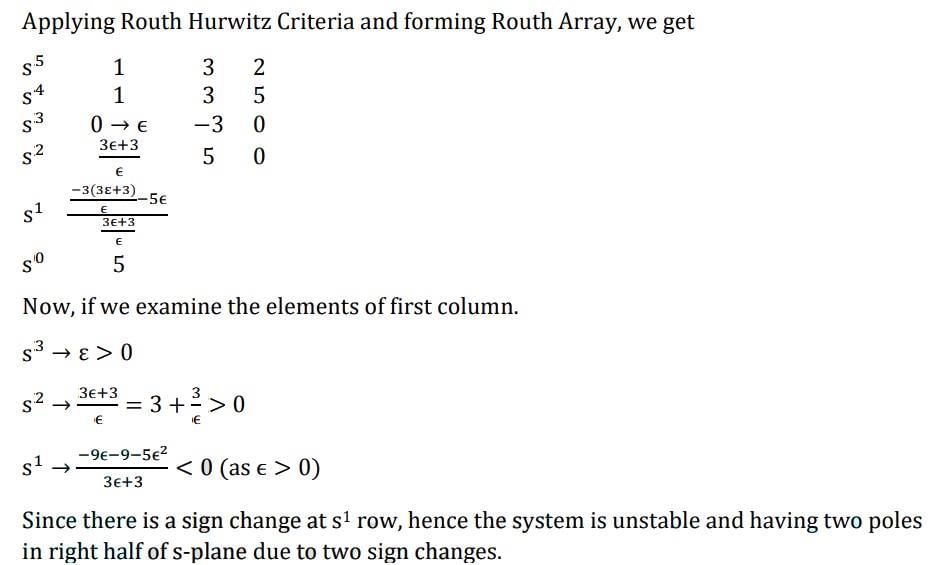Routh- Hurwitz Criterion | Control Systems - Electrical Engineering (EE) PDF Download
Before discussing the Routh-Hurwitz Criterion, let's study the stable, unstable and marginally stable system.
- Stable System: If all the roots of the characteristic equation lie on the left half of the 'S' plane then the system is said to be a stable system.
- Marginally Stable System: If all the roots of the system lie on the imaginary axis of the 'S' plane then the system is said to be marginally stable.
- Unstable System: If all the roots of the system lie on the right half of the 'S' plane then the system is said to be an unstable system.
Statement of Routh-Hurwitz Criterion
- Routh Hurwitz criterion states that any system can be stable if and only if all the roots of the first column have the same sign.
- If it does not has the same sign or there is a sign change then the number of sign changes in the first column is equal to the number of roots of the characteristic equation in the right half of the s-plane i.e. equals to the number of roots with positive real parts.
Necessary but not Sufficient Conditions for Stability
- We have to follow some conditions to make any system stable, or we can say that there are some necessary conditions to make the system stable.
- Consider a system with characteristic equation:

- All the coefficients of the equation should have the same sign.
- There should be no missing term.
- If all the coefficients have the same sign and there are no missing terms, we have no guarantee that the system will be stable. For this, we use Routh Hurwitz Criterion to check the stability of the system. If the above-given conditions are not satisfied, then the system is said to be unstable. This criterion is given by A. Hurwitz and E.J. Routh.
Advantages of Routh- Hurwitz Criterion
- We can find the stability of the system without solving the equation.
- We can easily determine the relative stability of the system.
- By this method, we can determine the range of K for stability.
- By this method, we can also determine the point of intersection for root locus with an imaginary axis.
Limitations of Routh- Hurwitz Criterion
- This criterion is applicable only for a linear system.
- It does not provide the exact location of poles on the right and left half of the S plane.
- In case of the characteristic equation, it is valid only for real coefficients.
The Routh- Hurwitz Criterion
Consider the following characteristic Polynomial

When the coefficients a0, a1, ......................an are all of the same sign, and none is zero.
Step 1: Arrange all the coefficients of the above equation in two rows:

Step 2: From these two rows we will form the third row:

Step 3: Now, we shall form fourth row by using second and third row:

Step 4: We shall continue this procedure of forming a new rows:
Determine whether the system is:
Example: Check the stability of the system whose characteristic equation is given by
s4 + 2s3 + 6s2 + 4s + 1 = 0
Sol:
Obtain the arrow of coefficients as follows

Since all the coefficients in the first column are of the same sign, i.e., positive, the given equation has no roots with positive real parts; therefore, the system is said to be stable.
PYQs: Competitive Exams
Q1: The open loop transfer function of a unity gain negative feedback system is given by  . The range of k for which the system is stable, is
. The range of k for which the system is stable, is
(a) K > 3
(b) K < 3
(c) K > 5
(d) K < 5
Ans: c
Sol:
Given
Routh-Hurwitz criteria can be used to determine the range of k for a stable system.
Characteristic equation , 1 + G(S) = 0
Routh table For a stable system, the element of the first column does not have any sign changes.
For a stable system, the element of the first column does not have any sign changes.
For that to happen
k - 5 > 0
or, k > 5
Therefore, option (c) is correct.
Q2: A single-input single-output feedback system has forward transfer function G(s) and feedback transfer function H(s). It is given that |G(s)H(s)| < 1. Which of the following is true about the stability of the system?
(a) The system is always stable
(b) The system is stable if all zeros of G(s)H(s) are in left half of the s-plane
(c) The system is stable if all poles of G(s)H(s) are in left half of the s-plane
(d) It is not possible to say whether or not the system is stable from the information given
Ans: c
Sol:
D(s) = 1 + G(s)H(s)
D(s) gives the roots of characteristic equation i.e. closed-loop poles.
Nyquist stability criteria state that the number of unstable closed-loop poles is equal to the number of unstable open-loop poles plus the number of encirclements of the origin of the Nyquist plot of the complex function D(s).
It can be slightly simplified if instead of plotting the function D(s) = 1 + G(s)H(s), we plot only the function G(s)H(s) around the point and count encirclement of the Nyquist plot of around the point (-1, j0).
From the principal of argument theorem, the number of encirclements about (-1, j0) is
N = P - Z
Where
P = Number of open-loop poles on the right half of s plane
Z = Number of closed-loop poles on the right half of s plane
Calculation:
For the given system, we have |G(s)H(s)| < 1
So, we may easily conclude that the Nyquist-plot intersect the negative real axis between 0 and -1 point, i.e. the Nyquist plot does not enclose the point (-1, 0) or in other words number of encirclements is zero.
⇒ N = 0
For a stable closed loop system, we must have Z = 0.
To get Z = 0, from the Nyquist criteria, P must be equal to zero.
Therefore, the system is stable if all poles of G(s)H(s) are in left half of the s-plane.
|
53 videos|107 docs|40 tests
|






















